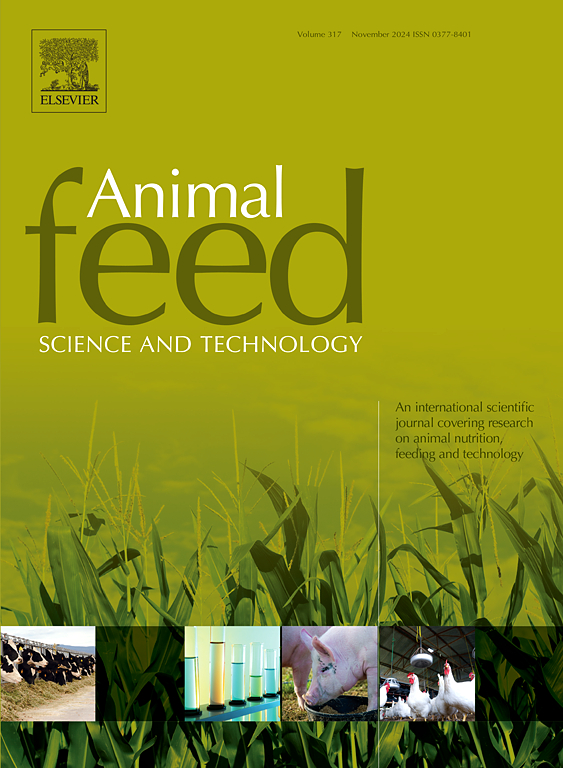饲喂新型低单宁、低单宁、中单宁或零单宁蚕豆品种对生长猪能量、淀粉、蛋白质和氨基酸消化率的影响
IF 2.7
2区 农林科学
Q1 AGRICULTURE, DAIRY & ANIMAL SCIENCE
引用次数: 0
摘要
蚕豆子叶中的疫苗和疫苗含量可诱发蚕豆病,这是一种红细胞缺乏葡萄糖-6-磷酸脱氢酶的溶血性贫血。蚕豆壳(testa)中的单宁在秋季夜晚具有抗冻性,但可能损害淀粉和粗蛋白质(CP)的消化率。本研究评估了饲喂不同单宁水平的新型低疫苗和疫苗蚕豆品种对生长猪能量、淀粉、CP和氨基酸(AA)消化率的影响,以降低人类健康风险。在约登方形设计中,13头回肠瘘管犊牛(32.6 ± 2.5 kg)分别饲喂9种蚕豆品种日粮中的1种(950 g/kg)和1种无氮日粮,在4天的日粮适应、2天的粪便收集和2天的食糜收集这9个时段内纠正内源性损失。低单宁、零单宁品种为CDC 219-16、DL 19.7202、DL Nevado和Navi。低剂量和单宁含量的品种有Allison、Dosis、Fabelle和Victus。品种淀粉和粗蛋白质含量平均分别为381和276 g/kg(原样)。无单宁品种的总纤维和不溶性纤维均比中单宁品种高11. %。各品种氨基酸平均含量分别为18 g/kg Lys、9 g/kg Thr、5 g/kg Met + Cys和2 g/kg Trp。除CDC 219-16(5.40和1.97 g/kg)外,品种和疫苗含量均较低(分别为0.83 g/kg和0.07 g/kg)。中单宁品种单宁含量比零单宁品种高83 % (13.3 vs. 7.3 g/kg)。零单宁组干物质(DM)和总能(GE)表观全道消化率系数(CATTD)分别比中单宁组高8 %和10 % (P <; 0.01)。零单宁组DM和GE的表观后肠发酵系数(CAHF)分别比中单宁组高45 %和77 % (P <; 0.01)。单宁含量为零的品种,除色氨酸低9 % (P <; 0.01)外,粗蛋白质和大部分氨基酸的标准化回肠消化率(CSID)比单宁含量为中的品种高5 %。零单宁与中单宁品种的消化能(DE)和净能(NE)预测值也高出10 % (13.36 vs 12.13 MJ DE/kg);分别为8.62和7.77 MJ NE/kg;P & lt; 0.01)。综上所述,新型低单宁和零单宁品种在纤维含量较高的情况下,DM和GE的CATTD和CAHF、CP和AA的CSID、DE和NE值均高于中单宁品种。本文章由计算机程序翻译,如有差异,请以英文原文为准。
Feeding novel low vicine and covicine, mid- or zero-tannin faba bean cultivars on energy, starch, protein and amino acid digestibility in growing pigs
Vicine and covicine content of faba bean cotyledons can induce favism, a haemolytic anaemia in humans with an erythrocyte deficiency of glucose-6-phosphate dehydrogenase. Tannins in faba bean hull (testa) offer frost tolerance during fall nights but may impair starch and crude protein (CP) digestibility. This study evaluated feeding novel low-vicine and covicine faba bean cultivars bred to reduce human health risk, with varying tannin levels on digestibility of energy, starch, CP, and amino acids (AA) in growing pigs. In a Youden square design, 13 ileal-cannulated barrows (32.6 ± 2.5 kg) were fed 1 of 9 faba bean cultivar diets (950 g/kg) and a nitrogen-free diet to correct for endogenous losses over 9˗11 periods consisting of 4 d of diet adaptation, 2 d of faecal collection, and 2 d of digesta collection. Low vicine and covicine, zero-tannin cultivars were CDC 219–16, DL 19.7202, DL Nevado, and Navi. Low vicine and covicine, tannin-containing cultivars were Allison, Dosis, Fabelle, and Victus. Cultivar starch and CP content averaged 381 and 276 g/kg (as is), respectively. Total and insoluble fibre were both 11 % greater in zero-tannin than mid-tannin cultivars. Amino acid content across cultivars averaged 18 g/kg Lys, 9 g/kg Thr, 5 g/kg Met + Cys, and 2 g/kg Trp. Cultivar vicine and covicine content was low (0.83 g/kg and 0.07 g/kg, respectively) except for CDC 219–16 (5.40 and 1.97 g/kg). Tannin content in mid-tannin cultivars was 83 % greater than in zero-tannin (13.3 vs. 7.3 g/kg). Coefficient of apparent total tract digestibility (CATTD) of dry matter (DM) and gross energy (GE) were 8 % and 10 % greater, respectively, in zero-tannin than mid-tannin diets (P < 0.01). Coefficient of apparent hindgut fermentation (CAHF) of DM and GE were 45 % and 77 % greater in zero-tannin than mid-tannin diets (P < 0.01). Zero-tannin cultivars had 5 % greater coefficient of standardised ileal digestibility (CSID) of CP and most AA than mid-tannin, except for Trp that was 9 % lower (P < 0.01). Zero-tannin vs. mid-tannin cultivars also provided 10 % greater digestible energy (DE) and predicted net energy (NE) values (13.36 vs. 12.13 MJ DE/kg; 8.62 vs. 7.77 MJ NE/kg, respectively; P < 0.01). In conclusion, despite greater fibre content, novel low-vicine and covicine zero-tannin cultivars had greater CATTD and CAHF of DM and GE, greater CSID of CP and AA, and greater DE and NE values than the mid-tannin cultivars.
求助全文
通过发布文献求助,成功后即可免费获取论文全文。
去求助
来源期刊

Animal Feed Science and Technology
农林科学-奶制品与动物科学
CiteScore
6.00
自引率
6.20%
发文量
266
审稿时长
3 months
期刊介绍:
Animal Feed Science and Technology is a unique journal publishing scientific papers of international interest focusing on animal feeds and their feeding.
Papers describing research on feed for ruminants and non-ruminants, including poultry, horses, companion animals and aquatic animals, are welcome.
The journal covers the following areas:
Nutritive value of feeds (e.g., assessment, improvement)
Methods of conserving and processing feeds that affect their nutritional value
Agronomic and climatic factors influencing the nutritive value of feeds
Utilization of feeds and the improvement of such
Metabolic, production, reproduction and health responses, as well as potential environmental impacts, of diet inputs and feed technologies (e.g., feeds, feed additives, feed components, mycotoxins)
Mathematical models relating directly to animal-feed interactions
Analytical and experimental methods for feed evaluation
Environmental impacts of feed technologies in animal production.
 求助内容:
求助内容: 应助结果提醒方式:
应助结果提醒方式:


